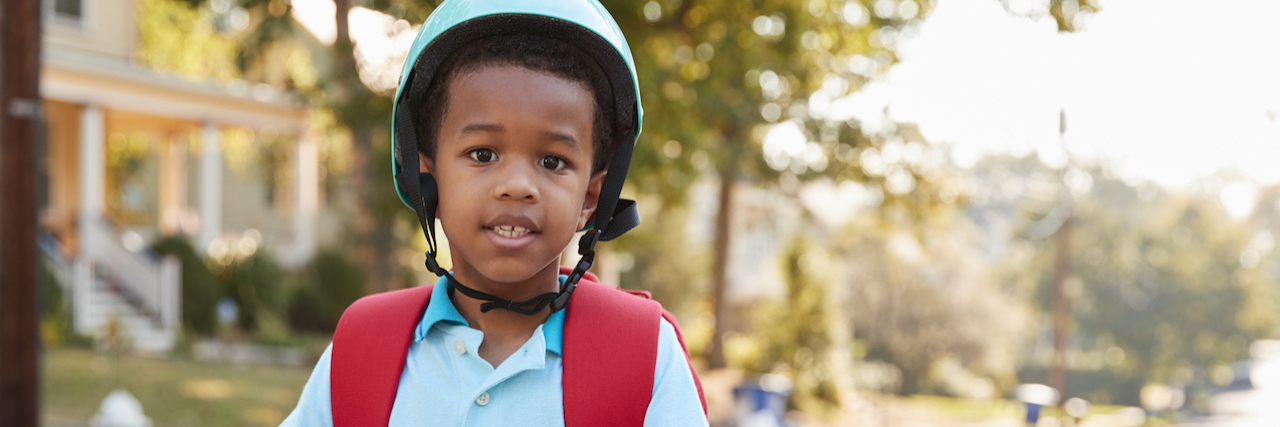My Son Is Black and Has Autism. Here’s How I’m Preparing Him to Interact With Police.
“Ding, correct!” My son smiled.
He’d gotten another answer right on his schoolwork online. The assignment was to look at the pictures and select the community helpers. The screen was filled with images of people who assist others. There was a nurse, dentist, firefighter and police officer. Each wore a smile and looked kind. The goal of the exercise was to help him identify who he could turn to if he ever needed help.
He slid the mouse across the mousepad preparing to click on the cute cartoon drawing of the police officer, and I nearly grabbed his arm to make him stop.
“Ding, correct!” He smiled again.
Questions flooded my mind.
My son has autism, and he’s Black. He smiles and laughs a lot and sometimes runs away while being spoken to. It takes a moment for him to process what others say and he sometimes wails uncontrollably when he gets yelled at even a little. How was I going to make him understand that his brown skin and unique behaviors can make him look like a threat and put him at risk of being treated unfairly or even physically abused at the hands of police?
Up until now his adorable smile and undeniable cuteness have protected him. I’m well aware that as puberty sets in, his voice deepens and his shoulders broaden, welcoming smiles will turn to frowns and contempt when certain people see him coming their way.
According to a study conducted by the National Center for Biotechnology Information, a branch of the National Institutes of Health, youth with autism displaying externalizing behaviors were more likely to be involved in the criminal justice system with approximately 20% being stopped and questioned and 5% being arrested by the age of 21. Add being Black to the mix and those numbers increase dramatically.
“Black men and boys are almost three times more likely than white men and boys to be killed by police. Consequently, if you have a Black and autistic child you must prepare them for interactions with law enforcement within their social skills repertoire,” says Joy Johnson (@joyfjohnson), a Baltimore-based autism advocate and Behavioral and Inclusion Specialist.
“Preparing your child may not only prevent tragedy from occurring, but also help them cope with their own anxieties during such a stressful situation and establish undoubted proof of misconduct on law enforcement’s behalf should it occur,” she said.
Johnson offers these tips parents and caregivers can use to prepare children and teens with autism for interactions with police:
- Develop and practice an individual specific vocal disclosure plan.
- Teach them to always keep their hands visible and to drop any objects.
- Practice when and how to obtain permission or to signal their intentions before reaching into their pockets, bag or the glove compartment of their vehicle.
- Develop and practice how to use a handout card that discloses their diagnosis, triggers (i.e. tactile aversions), and behaviors (i.e. stimming). If your child is nonvocal or vocal but subject to selective mutism this is essential.
- Practice when and how to to direct police to where their ID and/or handout card is located. For safety reasons, this is preferred over reaching into their own pockets unless they are directed to do so or are tactile defensive.
- Practice when and how to request to call an advocacy organization or personal advocate, relative or friend. The directions and contact information should be on the handout card.
- If they don’t understand their Miranda rights, practice responding, “No, I do not understand.” This should also be included in the handout card.
- Prepare them that they may be touched and equip them with coping strategies. These may include calming self talks or breathing techniques.
- Teach them not to run.
- Teach them not to touch a police officer’s dog.
- Teach them not to touch a police officer’s weapon or body.
For my son, a big conversation about police brutality and ways he can advocate for his needs during interactions with law enforcement would be overwhelming. So, I’ll use social stories filled with pictures and break what he needs to know into bite sized chunks. Even so, I know it will still be a lot for him to chew on. We will role play and repeat until he knows what to do and understands why he needs to do it. I know that one day he will, but I pray every day for the Black boys with autism who I know will not.
Related: I Am a Proud, Black, Nonspeaking Young Man With Autism. My Life Matters.
Getty image via monkeybusinessimages

